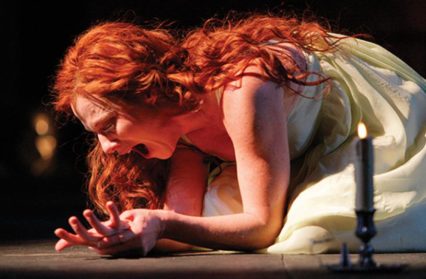As part of the ‘Shakespeare Lives!’ project, marking the 400th anniversary of the playwright’s death, the British Council collaborated with Chapter Arts Centre on a series of Shakespeare films, accompanied by panel discussions. The season opened with Kenneth Branagh’s Henry V (1989), followed by a discussion on Shakespeare and Wales.
If Shakespeare remains, even today, a small part of the Welsh question, Wales has always been a big part of the Shakespeare question. […] the plays attest to a lifelong awareness of and engagement with the Principality
(Willy Maley and Philip Schwyzer)
William Shakespeare is today such an icon of Englishness that it’s easy to forget how frequently his plays deal with Wales, and the way in which the Principality appears to its larger neighbour. The History plays, written under the partly-Welsh Tudor dynasty, show a recurring strain of Welsh characters, possibly all written for the same actor – the Welsh Captain in Richard II, whose change of allegiance marks the start of the king’s downfall, the fierce, mystical Glendower in Henry IV, Part I, who claims that he ‘can call spirits from the vasty deep’, and Fluellen (the playwright’s version of the Welsh name Llewellyn) in Henry V, proud and nationalistic, with his constant talk of the rules and scholarship of war. After the battle of Agincourt, Fluellen emphasizes the Welsh roots of the Monmouth-born King:
FLUELLEN
Your majesty says very true; if your majesties is remembered of it, the Welshmen did good service in a garden where leeks did grow, wearing leeks in their Monmouth caps; which, your majesty know, to this hour is an honourable badge of the service; and I do believe your majesty takes no scorn to wear the leek upon Saint Tavy’s day.
KING HENRY V
I wear it for a memorable honour;
For I am Welsh, you know good countryman.
Henry IV, Part I features Glendower’s daughter Lady Mortimer, a character who speaks exclusively in Welsh, and whose husband speaks only English, an extreme example of the playwright’s preoccupation with questions of communication and cultural difference. The character’s lines aren’t specified, suggesting that at least one member of Shakespeare’s company spoke Welsh. He himself probably didn’t, though it is possible that he heard the language as a child; his maternal grandmother, Alys Griffin, may have been a Welsh speaker, and the bilingual poet Gwyneth Lewis, who has translated The Tempest, believes (perhaps a little romantically, as she’d admit herself) that the song forms in his plays show a familiarity with Welsh verse.
Fluellen and Glendower reflect Elizabethan views of Wales, as associated both with mysticism and with learning – prominent Elizabethan intellectuals like the scholar and magician John Dee often played up their own Welsh ancestry. Shakespeare’s depiction of these characters may have also reflected his own experience; as well as his grandmother, the other influential Welsh figure in his childhood was his schoolmaster Thomas Jenkin. It’s not a coincidence that Welsh characters in the plays often have a verbose, slightly pedantic character; most obviously the teacher Hugh Evans in The Merry Wives of Windsor, who speaks English and Latin with a strong Welsh accent, and at one point is seen testing a young schoolboy named, significantly, William.
Welsh landscapes also appear in the History and Romance plays – Richard II hands over his crown at Flint Castle, the rebels against Henry IV meet at the Archdeacon’s house in Bangor, and Cymbeline is set partially in Milford Haven and the surrounding countryside, described in a stage direction as ‘ a mountainous country with a cave’. This wild West Walian landscape is home to the exiled princes Guiderius and Arviragus, and has a primal nature that’s set against the corrupt courts of Westminster and Rome.
The more remote Welsh landscapes have also been used in film adaptations: Gwynedd stood in for medieval Scotland in Roman Polanski’s Macbeth (1971), while the 2016 BBC Richard II, starring Ben Whishaw and Rory Kinnear, was filmed largely in Pembrokeshire, at locations including St. David’s Cathedral and Pembroke Castle. The film’s director, Rupert Goold, said that ‘There’s something very special about the cathedrals, the landscapes. It’s very difficult to find landscapes that can pass for the late 14th century, where there weren’t any fields, any pastures. So we were right down to the corner of Wales.’
Goold’s quote perhaps shows an Englishman’s view of Wales – simultaneously near and distant, both in terms of location and time. In this, he’s reflecting Shakespeare’s own view of the Principality – his Welsh characters and locations are both familiar and undeniably foreign, reflecting a relationship that remains ambiguous.
David Cottis is a film academic and theatre director
Additional research by Jessica Mordsley
Thanks to Rakie Ayola, Siobhan Brennan and Gwyneth Lewis













